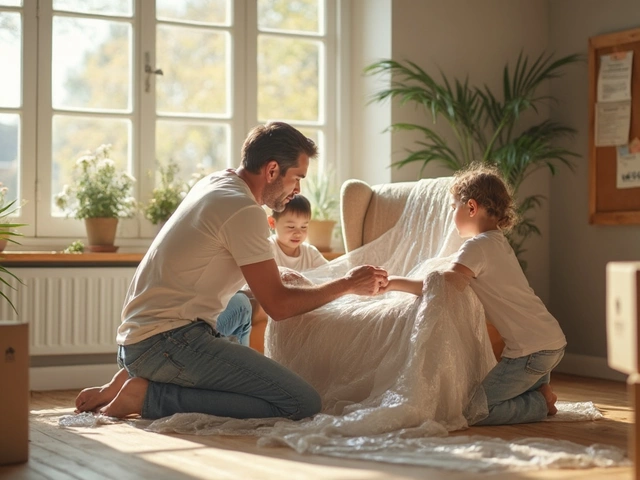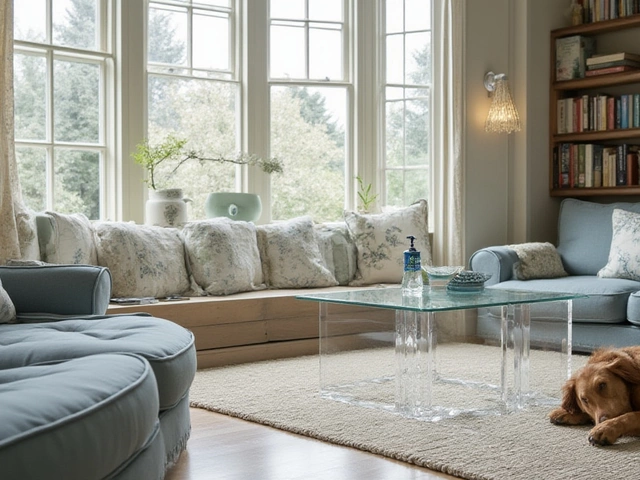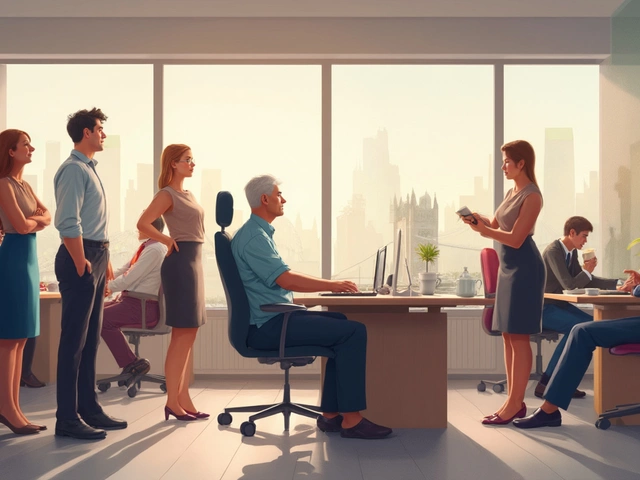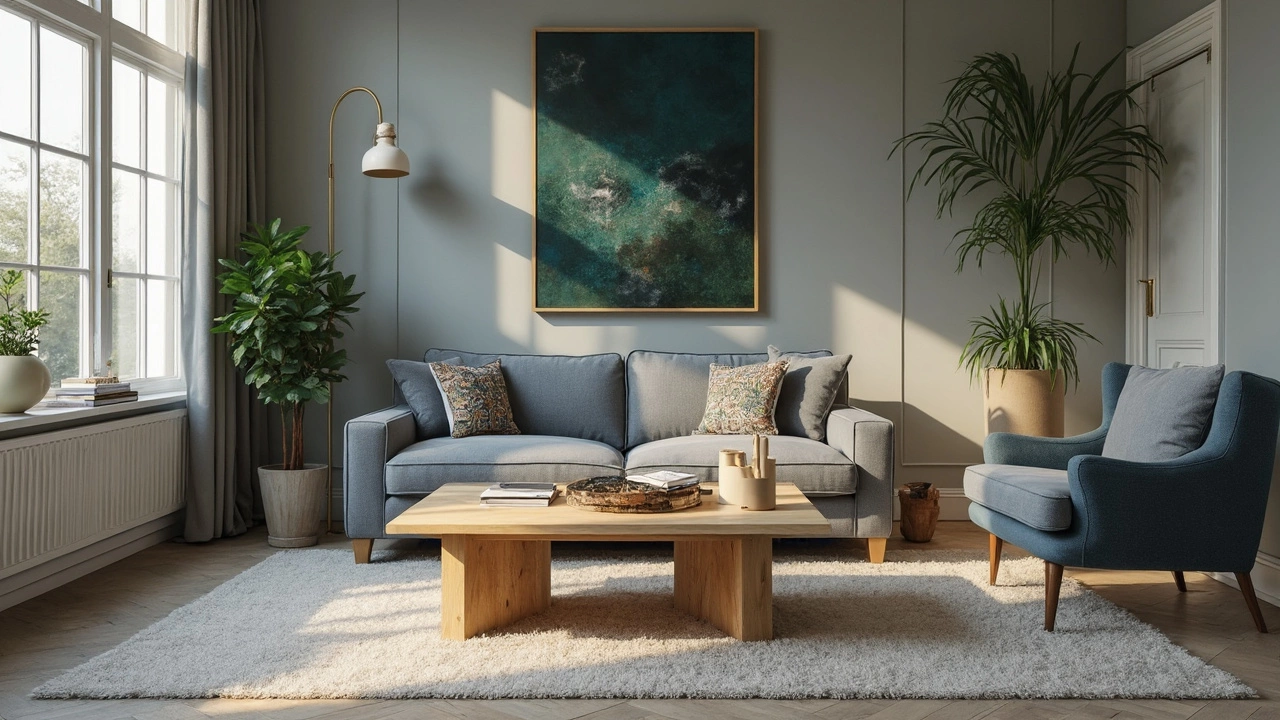 5
Feb,2025
5
Feb,2025
Ever wondered if your coffee table should be taller than your sofa? It's a question that pops up as you try to piece together a living room that doesn't just look good but feels right. A coffee table that's too high or too low can disrupt the flow of the room, both functionally and aesthetically. So what's the right choice for you?
The general rule of thumb is to keep your coffee table at about the same height as your sofa cushions. Typically, this means a table that stands about 16-18 inches tall. But this isn't a hard and fast rule. Some modern designs and personal preferences lead folks to choose a variety of heights that suit their style or how they use the space.
Why does height matter so much, anyway? Well, imagine balancing a tray of snacks on a table that seems like a skyscraper next to your seating. Not fun, right? On the other hand, if it's too low, bending or reaching down can feel more like yoga than relaxing with a cup of coffee. Start with considering how you use the space—hosting parties, casual nights in, or simply a place for magazines and remotes—and choose your table height accordingly.
- Understanding the Basics
- The Height Debate
- Pros and Cons
- Finding Your Sweet Spot
- Design Tips and Tricks
- Practical Considerations
Understanding the Basics
If you've ever stood in the furniture aisle, scratching your head at the array of coffee table choices, you're not alone. Matching the right table to your sofa is more than just picking what looks nice. It's about getting the proportions right so your living room feels balanced.
Let's get down to the nitty-gritty: height. The standard rule is simple—your coffee table should be about the same height as your sofa cushions, give or take a few inches. Most sofa furniture has seats roughly 17-19 inches tall, so aim for tables in that ballpark. Why? It ensures comfy use, whether you're grabbing a cup of joe or propping up your feet.
Why Height Matters
A coffee table that's too tall can throw off the room's vibe. It can make it awkward to relax and unwind. Too short, and you're stretching or bending, which is anything but comfortable. That balance creates a seamless interaction between your seating and table.
Finding the Right Size
While the height's key, don't forget about the length and width. A good guideline is choosing a table that's about two-thirds the size of your sofa. This ratio keeps your coffee table from overwhelming the room or feeling lost in the layout.
Quick Measurements and Tips
- Measure from the floor to the top of your sofa cushions to know your target coffee table height.
- For a cohesive look, keep your table about 12-18 inches away from the sofa.
- Balance length with seating size—two-thirds of your sofa's length is usually spot-on.
Understanding these basics is your first step in nailing home decor. Whether your style's modern minimalist or cozy traditional, sticking to these principles helps you design a living room that's both functional and inviting.
The Height Debate
Let's dig into why the height of your coffee table might just stir more discussions than you'd expect. At the heart of this debate is finding a balance between style and function. While traditional guidelines suggest the table height should match or be just below the sofa seat cushions, real-life choices often tell a different story.
What Works Best?
Traditionally, the target height for a coffee table is within two inches of the sofa seat height, whether it's slightly higher or lower. This rule got its start because it tends to create a visually pleasing line and makes it easy to access items on the table from a seated position.
Yet, with modern aesthetics and varying uses of living spaces, this "rule" should be more of a guideline than a hard rule. For example, higher coffee tables often work well in rooms with low-seated sofas or sectionals where the extra height compensates for the low seating position.
The Function Factor
Beyond just looks, think about what you actually use your table for. Got a lot of TV dinners? Hosting game nights where board games are spread out? A slightly higher table can be super handy.
Conversely, if your coffee table is more of a hub for decorating with trinkets and a few magazines, keeping it closer to the sofa’s height might make more sense. Home decor enthusiasts often highlight that lower tables can enhance the coziness and inviting feel of a room.
Quick Facts
- Standard coffee table height: 16-18 inches.
- Consider the sof a seat height first: Usually 17-19 inches.
- Adjust for purposes: Higher tables suit activities; lower tables fit relax zones.
Ultimately, the decision boils down to what feels best in your space and how it aligns with your room's purpose. So next time you're at a furniture store or rearranging your living room, remember this balance between beauty and functionality.
Pros and Cons
Deciding whether your coffee table height should be taller than your sofa can feel like a big choice, but breaking it down helps. Let’s look at the pros and cons to sort out what's best for your living area.
Pros of a Taller Coffee Table
If you decide to go with a higher table, it does come with some unique perks:
- Easy Access: Taller tables are perfect if you often use your coffee table to work or eat. You won’t have to hunch over awkwardly.
- Visual Interest: A higher table can add a level of vertical variety, making your living space look chic and layered.
- Storage Space: Some taller tables come with shelving or storage opportunities like drawers. More room to stash stuff is always a win.
Cons of a Taller Coffee Table
On the flip side, here’s where a taller coffee table might fall short:
- Overwhelming Size: If your other furniture is low, a tall table can look out of place, disrupting the overall aesthetic balance.
- Lack of Comfort: With a too-high table, you might find it uncomfortable if you're trying to put your feet up, and let's face it, who doesn’t do that every now and then?
- Space Constraints: Taller tables can block view lines and make small rooms feel crowded or choppy.
Striking a Balance
So how do you decide? Consider your daily habits and design preferences. For instance, an interior designer once advised that if you frequently entertain and need space for snacks and drinks, a slightly higher table might be practical. On the other hand, if your living room is your chill zone for binge-watching shows, maintaining a lower height could support coziness and relaxation.
Ultimately, it’s about what you find most appealing and practical. Blend function with style, and you’ll create a living room that ticks both boxes. Remember, there's no strict rule—it's your space to design!
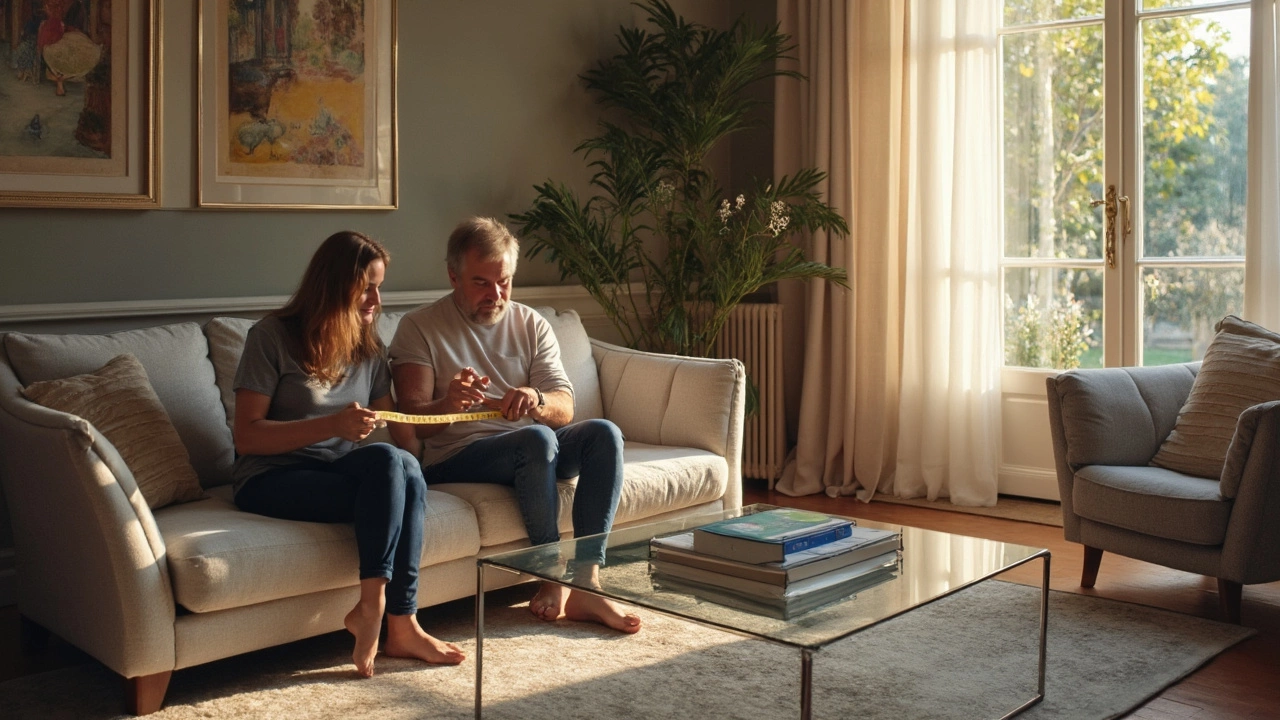
Finding Your Sweet Spot
So, how do you find that perfect balance with your coffee table height? Let's break it down with some straightforward pointers. First, grab a measuring tape. Most people are comfy with their coffee table being the same height as their sofa cushions or just an inch or two lower. This usually falls within the 16-18 inch range. But hey, rules are meant to be flexed, right?
Start by sitting on your sofa; your knees should align pretty closely with the table height. Not perfect? Adjust the coffee table legs if they’re adjustable, or consider a new piece if necessary. For those who love a more European or bohemian vibe, a lower coffee table might do the trick, creating a laid-back chill zone.
Practical Tips
- Sofa Height: Standard sofas often have a seat height of around 18 inches, making it a common target for aligning your table.
- Usage: If you’re a frequent entertainer or have kids, a slightly lower table can work better for creating a kid-friendly zone or for easy access during gatherings.
- Room Design: A higher table can double as a workspace for those who use their living room as a multifunctional area.
Test It Out
When you've got a potential table, test it out. Place items you typically use, like books or a laptop, to get a feel of its functionality. Visual balance matters too, so leave some space—your coffee table should be proportionate, not clunky or oversized.
Statistics to Consider
To give you some perspective, a survey found that 68% of people prefer their coffee tables the same height or slightly lower than their sofa. Another fun fact? Lower coffee tables are trending, especially in open-plan spaces where flow and movement are key.
Remember, choosing the right height is personal. Your habits, the size of your living space, and your furniture configuration all come into play. Don't shy away from experimenting until it feels perfect. After all, the right coffee table height can turn your home decor from meh to inviting in an instant!
Design Tips and Tricks
Adding a coffee table to your living space is more than just filling up space. It’s about style, functionality, and making sure it meshes well with your sofa. Let's chat about some practical ways to get your setup just right.
Balance and Proportion
Think of your coffee table as the anchor in your room’s design. It shouldn't feel overpowering or get lost in the decor. A good rule? Make sure the table is about two-thirds the length of your sofa. This gives a sense of balance without overwhelming your seating area.
Use of Space
You'll want at least 18 inches between your coffee table and the sofa for easy movement. Ensuring this space lets folks easily navigate around the room without knocking knees or having to squeeze through awkward gaps.
Material and Texture
Choose materials that echo your room's vibe. A glass table top gives a sleek, modern look and helps a small room feel more open. Wood, on the other hand, gives a cozy, traditional spin. Experiment with mixed materials too. It can add a layer of depth and intrigue.
Aesthetic Tricks
- For a chic look, layer books, candles, and small artifacts. Group items in groups of three or five for visual appeal.
- Use a table that reflects some light. Metallic elements can make it pop in an ambient light setting.
- Change decor pieces seasonally for a fresh feel without buying new furniture.
Table Shapes
Your choice here affects both function and feel. Rectangular tables work great in large rooms, providing lots of surface area. Meanwhile, round or oval tables can soften the look and are friendly for families with small kiddos running around.
Style Stats
| Shape | Average Preference |
|---|---|
| Rectangular | 60% |
| Round | 25% |
| Other | 15% |
By mixing these elements thoughtfully, you ensure your coffee table isn't just a random piece of furniture, but an integral part of your living space story. Keep experimenting and you'll find what makes your room feel just right!
Practical Considerations
When deciding on the height of your coffee table relative to your sofa, there are several practical considerations to keep in mind. First, think about what you routinely do in your living space. If you're a fan of intense board game nights or love hosting movie marathons, the height will impact comfort and accessibility.
Functionality
To make sure your living space works for you, ensure that the coffee table height allows easy reach from a seated position. If you're the type to snack between binge-watching sessions, a table that's too low might have you constantly on edge—leaning forward more than you'd like. Ideally, your table should be no more than 2 inches above or below the sofa seat height.
Space and Movement
Consider the space around your table. You’ll want at least 12 to 18 inches between the coffee table and the sofa to allow for easy navigation. Cramping the area can make your room feel smaller and is annoying for daily use.
Safety
For households with kids, don’t overlook the importance of rounded edges. Kids love to explore, and a coffee table that’s at their head level minus soft corners can lead to accidents. Look for tables with rounded edges or protect sharp corners with guards.
Style and Appearance
The right coffee table can tie your living room together. Consider how the coffee table height will fit with other furniture pieces like side tables and console stands. A matching visual line of height can create a more cohesive and polished look.
Quick Tips
- Keep a measuring tape handy when shopping to verify dimensions fit your needs.
- Try sitting in your regular spot and mimic everyday activities like placing a drink on an imagined table to visualize comfort.
- Don't be afraid to personalize! Make adjustments that fit your unique lifestyle and preferences.
All these points guide you toward choosing a table that's not only a good fit for your style but also meets the demands of your daily life. Applying these tips ensures your coffee table enhances the comfort and usability of your living space.

